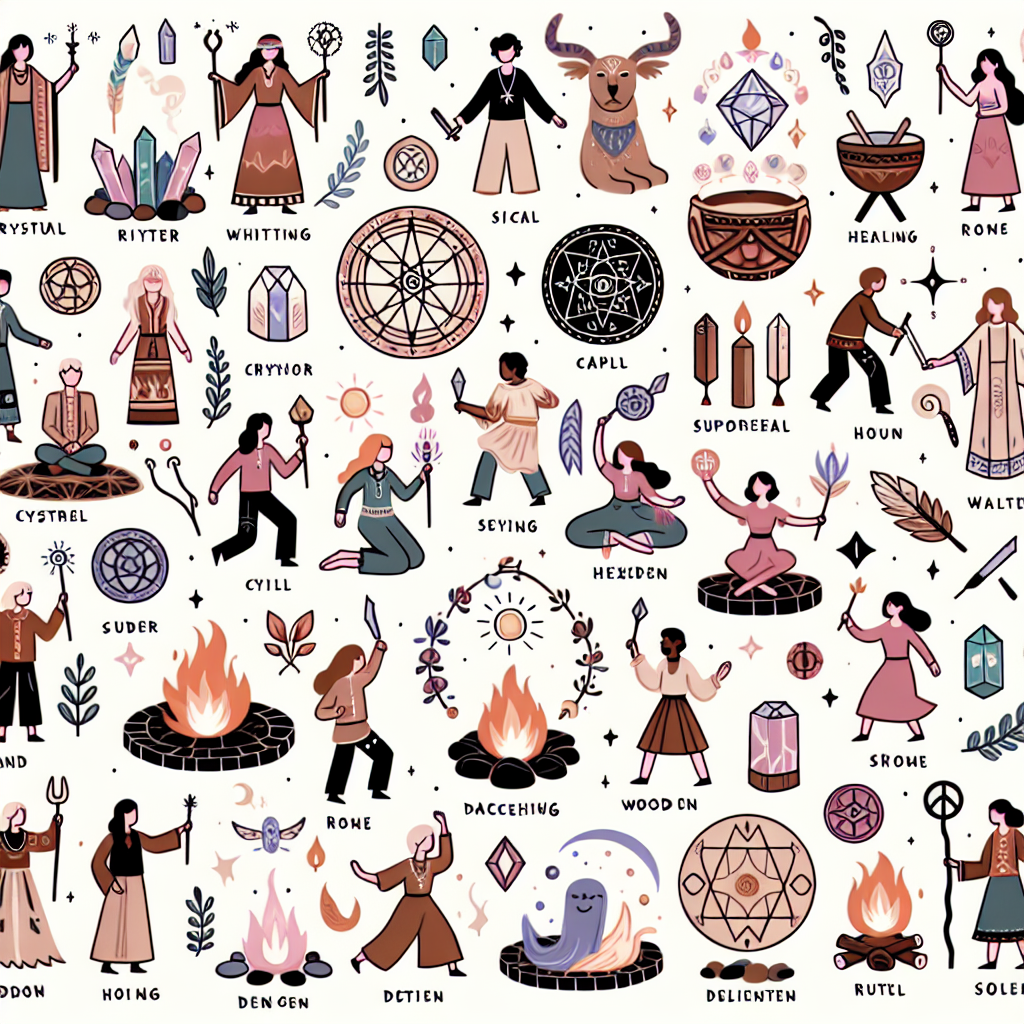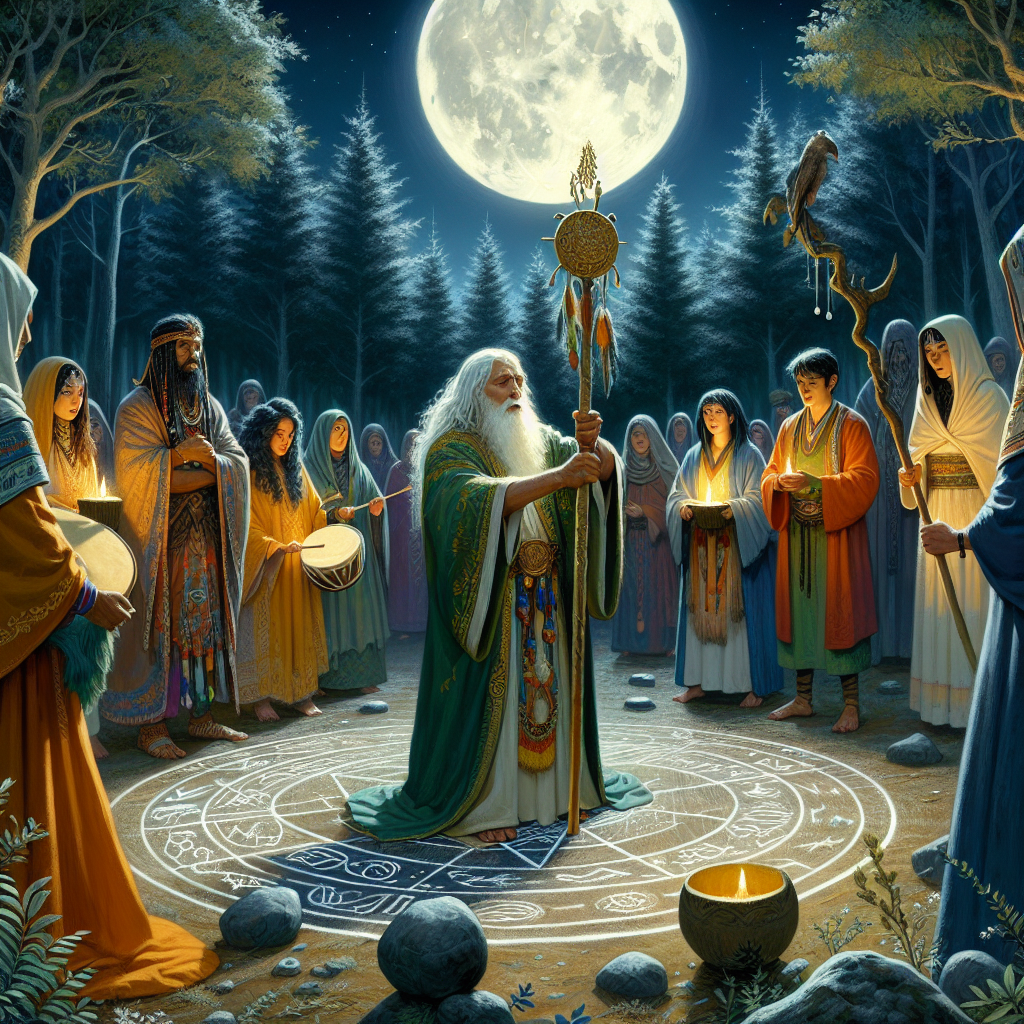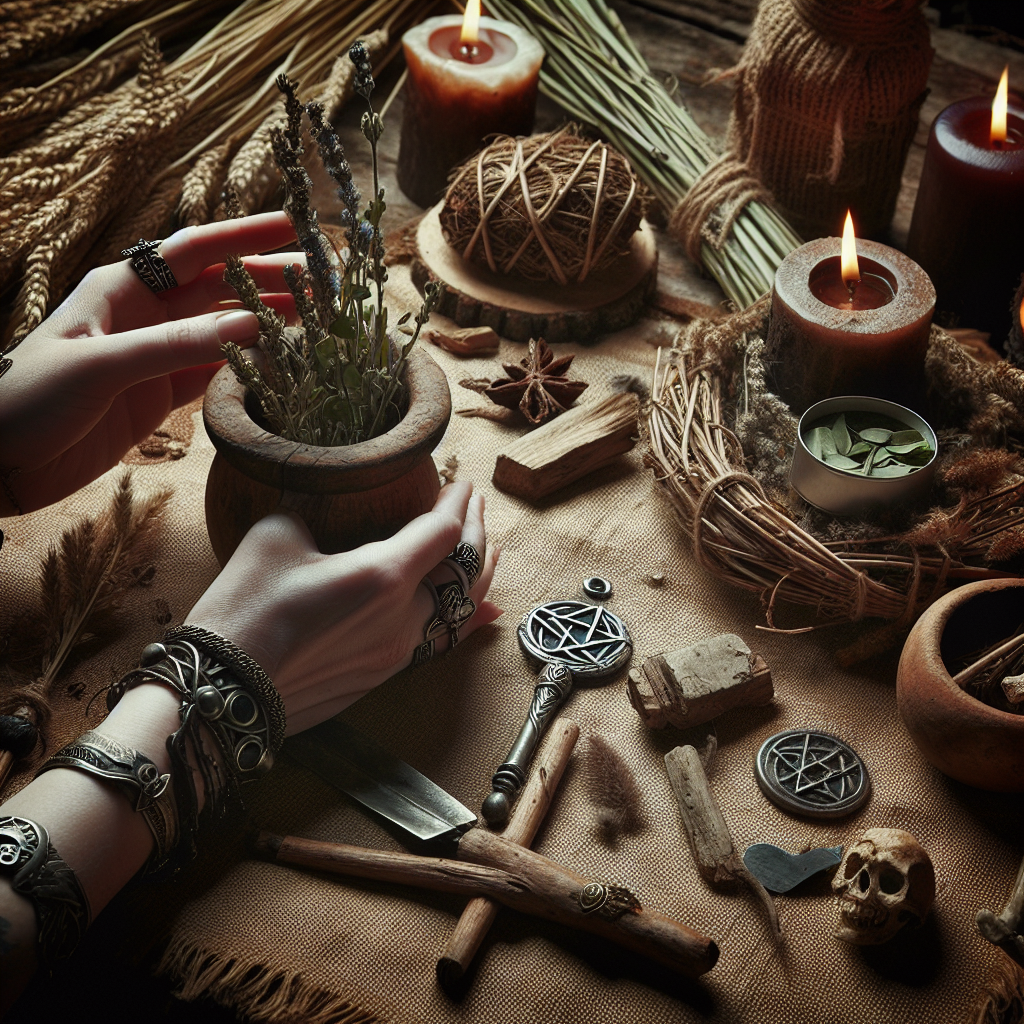As an Amazon Associate I earn from qualifying purchases.

Paganism, with its deep roots in ancient civilizations, is a spiritual path that honors the earth and recognizes the divine in many forms. This spectrum of traditions and rituals can vary widely, encompassing various polytheistic and nature-based beliefs. Among these, there are 40 rituals that continue to play a transformative role in the spiritual practice of modern Pagans.
The origins of these 40 rituals can be traced back to a rich tapestry woven from the threads of early European, Middle Eastern, and even African traditions, among others. They have evolved through the ages, influenced by the rebirth of Paganism in the 20th century through movements such as Wicca and Druidry. These rituals serve critical functions within the spiritual practice: they mark the changing of seasons, celebrate cycles of the moon, and invoke protective and compassionate energies, to name a few.
One of the most striking aspects of Pagan rituals is their connection to the natural cycle of the year, especially the eight sabbats or festivals celebrated by many Pagans. These include the solstices, equinoxes, and points in between, each with their own distinct rituals and symbolic meanings. Research shows that celebrating these seasonal festivals can greatly enhance one’s attunement to the natural world, with numerous Pagans reporting a deeper sense of harmony and wellbeing.
Engagement in these rituals often involves a variety of practices, such as casting circles to create sacred space, invoking deities or elemental forces, and conducting energy work to promote healing and personal growth. Some rituals are done solo, while others are celebrated within a group or coven, emphasizing community and shared spiritual purpose.
Furthermore, a compelling feature of these Pagan practices is their adaptability. They can be tailored to individual spiritual paths or eclectic practices, allowing practitioners to infuse them with personal significance. This adaptability not only aids in spiritual fulfillment but also encourages inclusivity within the broad spectrum of Pagan beliefs.
One ritual that underscores the transformative power of Pagan practices is the full moon esbat, which honors the feminine divine and celebrates the moon’s energy. During an esbat, participants might engage in meditation, divination, or spellwork aimed at channeling the lunar power for personal and collective good. Across the globe, full moon gatherings constitute a vital ritual for Pagans, with timestamps dating back thousands of years, illustrating the moon's enduring mystical allure.
Another central ritual is the celebration of Beltane, marking the start of the pastoral summer season. In this festival, fire plays a prominent role, symbolizing purification and the life-giving power of the sun. Traditional practices might include the lighting of bonfires, Maypole dancing, and rites of union. This intertwining of community, energies of the season, and ritual actions create a potent blend for spiritual enlightenment and growth.
These ancient customs embody not only a link to the past but also a living, breathing component of the contemporary Pagan experience. With each performed ritual, there is a reaffirmation of the practitioners' beliefs and a conscious contribution to the collective continuity of these age-old traditions. Such ongoing practice underscores the vibrancy and resilience of Pagan spiritual life in the modern world.
Pagan rituals have been a part of human spiritual practices for thousands of years, encompassing a broad spectrum of traditions and beliefs. For those seeking to enhance their spiritual path through pagan practices, here are 40 rituals that can offer transformative experiences:
1. **Sabbat Celebrations**: Observing the Wheel of the Year through the eight Sabbats—Samhain, Yule, Imbolc, Ostara, Beltane, Litha, Lammas, and Mabon—is a central aspect of pagan practice, each with its own specific rituals to honor the seasons and cycles of nature.
2. **Esbat Rites**: Monthly full moon celebrations, known as Esbats, allow practitioners to connect with lunar energies, perform divination, and conduct magickal workings.
3. **Ancestor Veneration**: Honoring those who came before us, this can be done through offerings, building altars, or holding feasts in their memory.
4. **Nature Walks**: One of the simplest pagan rituals, communing with nature through mindful walks, brings a deeper appreciation of the Earth and its spirits.
5. **Elemental Balancing**: Calls upon the elements of Earth, Air, Fire, and Water to balance a practitioner's energy through ritual and meditation.
6. **Candle Magick**: Utilizing candles of specific colors and intentions to focus energy and manifest desires.
7. **Herbal Bundling**: Crafting bundles of herbs for smudging or offerings, tying into the energetics of different plants.
8. **Crystal Grids**: Creating grids with stones and crystals according to geometric patterns to channel energies for specific purposes.
9. **Drawing Down the Moon**: Invoking the goddess within, during an Esbat ritual to connect with divine feminine energies.
10. **Sunrise Rituals**: Greet the dawn with rituals that honor the sun and the new opportunities each day brings.
11. **Chanting and Mantras**: Using the power of voice to raise energy and align with specific vibrations or deities.
12. **Sacred Fires**: Building fires to connect with the transformative power of flame, often accompanied by offerings or written intentions that are cast into the blaze.
13. **Ritual Baths**: Using water, essential oils, herbs, and intention to cleanse the aura and rejuvenate the spirit.
14. **Sacred Dance**: Engaging in dance as a form of worship and an expression of connection to divine energies.
15. **Sigil Crafting**: Creating sigils, or magickal symbols, meant to represent and manifest specific goals or desires.
16. **Cord Cutting**: A ritual to energetically sever ties that no longer serve one’s highest good.
17. **Seasonal Crafts**: Creating items such as wreaths or charms that correspond to the energies of the current season.
18. **Divination Practices**: Utilizing tools such as tarot cards, runes, or scrying to gain insight and guidance.
19. **Energy Work**: Working with the chakras, auras, or meridians to heal and balance one's energetic body.
20. **Sacred Mealtimes**: Turning the act of eating into a ritual by giving thanks, consciously sourcing food, and eating mindfully.
21. **Land Blessings**: Offering blessings to the land, asking for permission and protection when working magickally in nature.
22. **Drumming Circles**: Using rhythm as a way to connect with the heartbeat of the Earth and to enter trance states.
23. **Astral Projection**: Working with techniques to consciously travel on the astral plane for spiritual work.
24. **Dreamwork**: Delving into the messages of dreams for spiritual growth and subconscious exploration.
25. **Knot Magick**: Tying knots while focusing on intentions, allowing the knots to hold and release energy when desired.
26. **Gardening with Intention**: Embedding magickal intention into the act of gardening, from the planting of seeds to the harvesting of herbs and plants.
27. **Vision Quests**: Undertaking a personal spiritual journey, often in nature, to gain insight and self-awareness.
28. **Poppet Creation**: Crafting dolls representing individuals for healing, protection, or other magickal workings.
29. **Brewing Potions**: Making teas, tinctures, or other concoctions with magickal properties.
30. **Book of Shadows**: Keeping a personal magickal diary for tracking moon phases, spells, and personal reflections.
31. **Protection Spells**: Casting spells designed to safeguard oneself or one’s space from negative influences.
32. **Wand Making**: Creating a wand from natural materials to channel energy in ritual work.
33. **Bindings**: Performing rituals to prevent harm or undesired actions, often enacted with the best of intentions.
34. **Spiritual Journeys**: Physical travel to places of power or pilgrimage to deepen one’s spiritual practice.
35. **Talisman Charging**: Empowering objects with protective or positive energy to carry with the practitioner.
36. **Feasting and Festivity**: Holding celebrations combined with ritual to honor deities, the Earth, or community.
37. **Ritual Tattoos**: Using the body as a canvas for symbols and signs that hold personal spiritual significance.
38. **Altar Arrangements**: Creating and maintaining an altar as a sacred space for worship, reflection, and magick.
39. **Pathworking**: Meditative journeys, often guided, to explore the self, the subconscious, or the realms of the divine.
40. **Releasing Ceremonies**: Rituals for letting go of the old to make way for the new, such as those held at the end of the year or after significant life changes.
Engaging in these pagan rituals can foster a profound connection to the natural world, the self, and the spirit. Each of these practices can be customized to fit individual beliefs and paths, making them highly adaptable for personal spiritual exploration. According to a Pew Research Center survey on religious and spiritual practices, around 0.3% of Americans (roughly 1 million people) identify as Pagan or Wiccan, highlighting the persistence and modern relevance of these ancient practices.
- What are pagan rituals and how do they transform spiritual practice?
Pagan rituals are ceremonial acts that are part of various polytheistic or nature-based spiritual traditions. They often involve elements such as chanting, dancing, offerings, and the invocation of deities or spirits. These rituals can transform spiritual practice by helping practitioners connect with the divine, nature, and their inner selves, fostering a sense of harmony and spirituality.
- Can I practice pagan rituals if I belong to a different religion?
Yes, many people incorporate elements of pagan rituals into their spiritual practice while still adhering to their own religious beliefs. However, it's important to approach these rituals with respect for their cultural origins and with an understanding of their symbolic meanings.
- Are pagan rituals safe to perform?
Most pagan rituals are safe as long as they are conducted with positive intentions and a clear understanding of the ritual's components. It's important to prepare properly and ensure that any physical actions undertaken are done so with safety in mind.
- Do I need special tools or items to perform pagan rituals?
While certain rituals may suggest or require the use of specific tools, such as candles, crystals, or herbs, many can be performed with everyday items or without any tools at all. The focus is often more on the intent and the symbolic value of the actions rather than on the materials used.
- How can I learn more about the meanings behind pagan rituals?
Learning about pagan rituals can be done through reading books, attending workshops, joining pagan communities, or seeking guidance from experienced practitioners. It's important to research and understand the cultural context and symbolism behind the rituals to practice them respectfully and effectively.
- Can pagan rituals be performed in groups or are they solitary practices?
Pagan rituals can be tailored to both group settings and solitary practice. Some rituals are traditionally conducted with a coven or community, while others can be personalized for individual spiritual work.
- How often should I perform pagan rituals?
The frequency of performing pagan rituals depends on your personal spiritual needs and the specific tradition you follow. Some may choose to perform rituals daily, during sabbats and esbats, or whenever they feel the need for spiritual connection.
- Is there a certain time or place that is best for performing pagan rituals?
The effectiveness of a pagan ritual can be influenced by the time and place. Many rituals align with natural cycles, such as phases of the moon, seasonal changes, or specific times of day. As for location, a quiet and respectful environment—whether indoors or in nature—can enhance the ritual's significance.
- How do I know if I am performing a pagan ritual correctly?
As with many spiritual practices, intention and sincerity are more important than perfection. Familiarize yourself with the ritual's steps and their meanings, and perform them to the best of your ability. Reflecting on the experience can help you understand if the ritual was effective for you.
- What should I do if a pagan ritual doesn't seem to work for me?
Not all rituals resonate with every individual. If a ritual doesn't work for you, reflect on the experience to determine if there's an aspect that felt disconnected or inauthentic. You may need to try different rituals, adapt certain elements to better suit your beliefs, or further explore what you're seeking from your spiritual practice.

Conclusion
The exploration of the 40 pagan rituals reveals a rich tapestry of spiritual practices that serve to deepen our connection with the natural world and the myriad energies that flow through it. These rituals, ranging from the simple acts of lighting candles to honor the elements, to the more intricate ceremonies aligned with the lunar cycles, provide a pathway to enhance self-awareness, personal growth, and a sense of harmony with the cosmos. Throughout the article, we have seen how each ritual is steeped in ancient wisdom and can be adapted to contemporary life, offering timeless relevance and transformative potential for practitioners seeking a more profound spiritual existence.
Significantly, the rituals discussed do not only aid in personal development but also foster a sense of community and shared purpose among participants. They encourage respect for tradition, the environment, and one another, thus weaving a web of interconnection that transcends individual practices. By incorporating these rituals into their spiritual repertoire, individuals tap into a wellspring of cultural heritage and collective energy that has been refined and re-energized over countless generations. The powerful combination of intention, action, and reflection inherent in these pagan rituals proves to be a compelling force for those who wish to walk a path of spiritual enrichment and ecological mindfulness.
Amazon and the Amazon logo are trademarks of Amazon.com, Inc, or its affiliates.


